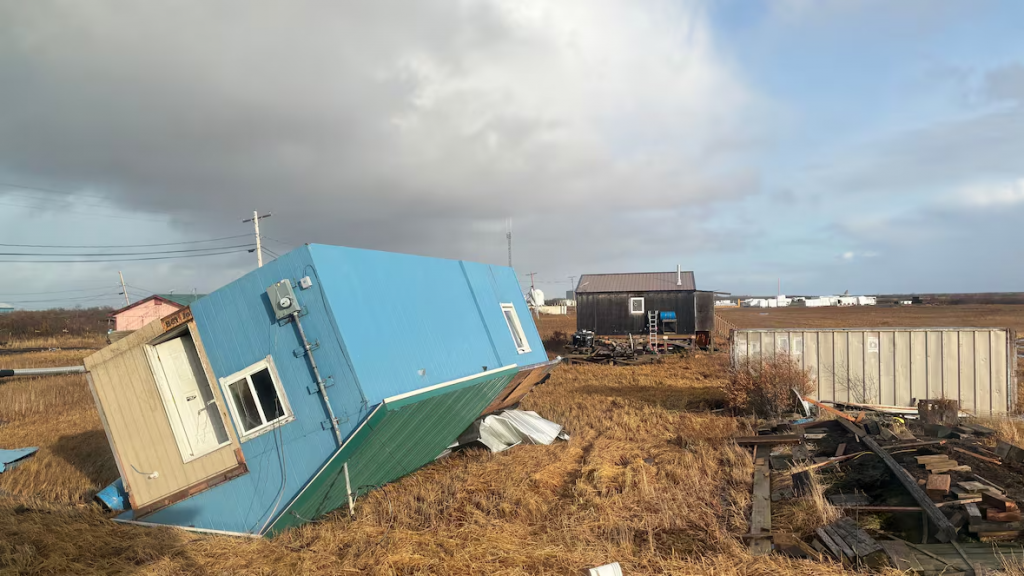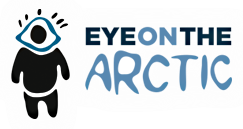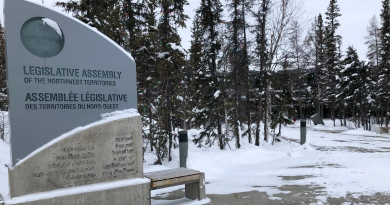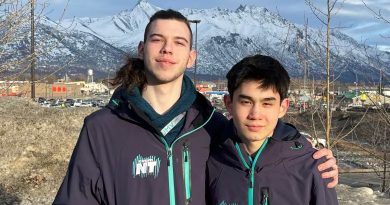Indigenous villages in Alaska face ‘absolute devastation’ after Typhoon Halong

Republican senator says Trump administration needs to take climate change effects on Alaska more seriously
One person is dead and two are missing in western Alaska after the remnants of Typhoon Halong over the weekend brought hurricane-force winds and ravaging storm surges and floodwaters that swept some homes away, authorities said.
More than 50 people have been rescued — some plucked from rooftops, officials said, warning of a long road to recovery and a need for continued support for the hardest-hit communities.
A U.S. Coast Guard official, Capt. Christopher Culpepper, described the situation in the villages of Kipnuk and Kwigillingok as “absolute devastation.”
Alaska State Troopers said at least 51 people and two dogs were rescued in Kipnuk and Kwigillingok after the storm system walloped the communities. Both areas saw significant storm surge, according to the National Weather Service.
A woman was found dead and two people remained unaccounted for in Kwigillingok, troopers said. The agency earlier said it was working to confirm secondhand reports of people who were unaccounted for in Kipnuk, but late Monday, troopers had determined no one there was missing.
According to the non-profit Coastal Villages Region Fund, most of the residents in both communities had taken shelter in local schools.
About 380 people live in Kwigillingok, a predominately Indigenous community on the western shore of Kuskokwim Bay and near the mouth of the Kuskokwim River.
Low-lying region susceptible to flooding
A report prepared for the local Indigenous residents in 2022 by the Alaska Institute for Justice said the frequency and severity of flooding in the low-lying region had increased in recent years. The report listed relocation of the community as an urgent need.
In addition to housing concerns, residents impacted by the system across the region reported power outages, a lack of running water, subsistence foods stocked in freezers ruined and damage to home-heating stoves. That damage could make the winter difficult in remote communities, where people store food from hunting and fishing to help make it through the season.
Jamie Jenkins, 42, who lives in another hard-hit community, Napakiak, said the storm was “the worst I’ve ever seen.” She described howling winds and fast-rising waters Sunday morning.
Her mother — whose nearby home shifted on its foundation — and a neighbour whose home flooded had come over to Jenkins’ place. They tried to wait out the storm, she said, but when the waters reached their top stairs, they got in a boat and went to the school.
Jenkins said “practically the whole community” was there.
The men in town gathered boats and went house to house to pick up anyone who was still in their homes, she said.
Adaline Pete, who lives in another community, Kotlik, said she had never experienced winds so strong before. An unoccupied house next door flipped over, but she said her family felt safe in their home.
During a news conference organized by Gov. Mike Dunleavy, Alaska’s two U.S. senators, Lisa Murkowski and Dan Sullivan, said they would continue to focus on climate resilience and infrastructure funds for Alaska. Sullivan said it was the congressional delegation’s job to ensure the Trump administration and their colleagues understood the importance of such funds.
Earlier this year, the Federal Emergency Management Agency said it would end a program aimed at mitigating disaster risks. The decision is being challenged in court.
Murkowski said erosion mitigation projects take time to complete.
“But our reality is, we are seeing these storms coming … certainly on a more frequent basis, and the intensity that we’re seeing seems to be accumulating as well, and so the time to act on it is now because it’s going to take us some time to get these in place,” she said of such projects.
Erosion and melting permafrost pose threats to infrastructure and in some cases entire communities in Alaska, which is experiencing the impacts of climate change.
Related stories from around the North:
Canada: Evacuation alert lifted in Old Crow, Yukon as risk of ice-jam flooding passes, CBC News
United States: Bursting ice dam in Alaska highlights risks of glacial flooding around the globe, The Associated Press



